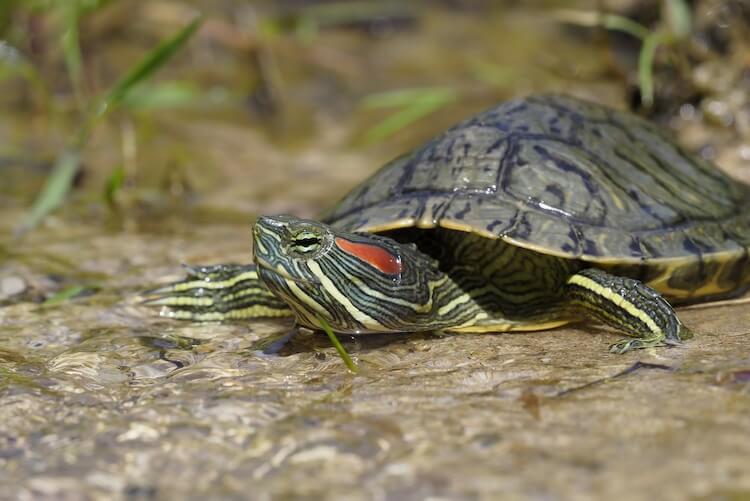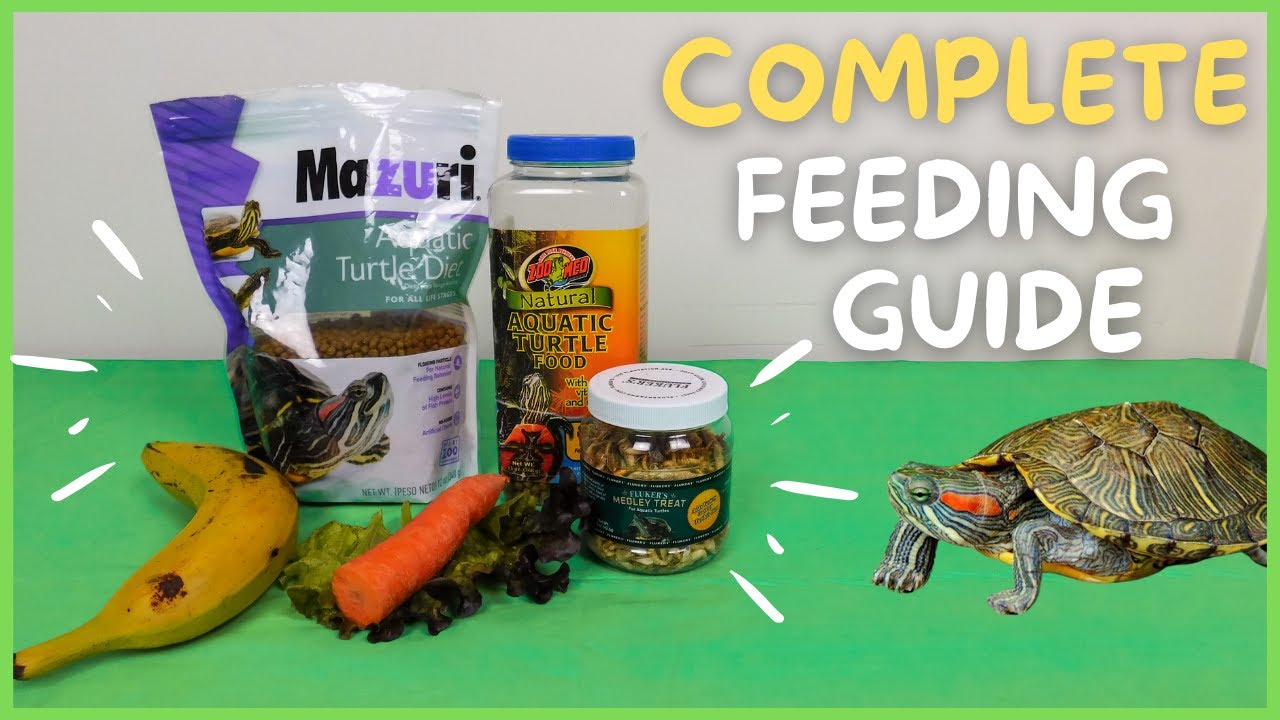To feed a red-eared slider turtle, provide a balanced diet of commercially available turtle food, supplemented with dark leafy greens, vegetables, and occasional protein sources such as crickets and earthworms. Red-eared slider turtles are one of the most popular species of aquatic turtles kept as pets.
They have a varied diet and can eat a range of commercial turtle foods like pellets, sticks, and bits, but you should still offer them fresh greens such as spinach, kale, and collard greens and vegetables like carrots and squash.
Extra protein can be provided through feeder fish once a week or occasional live insects like crickets, earthworms, and mealworms. Be careful not to overfeed your pet turtle, as obesity can lead to health problems. Additionally, make sure to change the water in their tank often and keep their enclosure clean to maintain their overall health and wellbeing.

Credit: www.everythingreptiles.com
Understanding Red Eared Slider Turtles
Red eared slider turtles are a popular choice for pet owners. They are known for their bright red stripes that run along their heads. Red eared sliders are considered semiaquatic, meaning they spend time both in the water and on land.
These turtles are known for their vibrant personalities and curious nature. In their natural habitat, red eared slider turtles can be found in north america in bodies of water such as ponds, lakes, and streams. They’re omnivores and in the wild, they feed on a diet that consists of both plants and animals.
In captivity, they can be fed a variety of vegetables, fruits, and proteins such as commercially prepared turtle food, small insects, and even cooked chicken or fish. Keep in mind that a well-balanced diet is key to keeping your red eared slider turtle healthy.
Factors To Consider While Feeding Red Eared Slider Turtles
Feeding your red-eared slider turtle the right type of food is essential for their growth and development. When it comes to feeding your turtle, age and size should be the foremost factors to consider. Younger and smaller turtles require more protein-rich food to help them grow, while older and larger turtles need a diet rich in fiber content to maintain their health.
Apart from considering your turtle’s age and size, it is equally important to provide them with a balanced and varied diet. You can offer a variety of food, including pellets and fresh vegetables such as lettuce, carrots, and cucumbers. Moreover, avoid giving junk food or any food that contains preservatives or high amounts of fat.
To ensure that your turtle gets all the necessary nutrients, consult with a veterinarian and learn about the nutritional requirements of red-eared slider turtles.
Best Diet Practices For Red Eared Slider Turtles
Red eared slider turtles are omnivores, so their diet comprises vegetables, fruits, and protein. Dark leafy greens, tomatoes, carrots, and squash are some suggested vegetables. For fruit, melons, strawberries, apples, and bananas are ideal options. Their primary protein source should come from animal-based food, such as insects, worms, and cooked meats like chicken and fish.
Young turtles will require higher protein intake than adults. Hatchlings should be fed every day, while adult turtles can go without food for up to three days. It’s important to only feed the turtle small portions to avoid overfeeding and health problems.
Variety in a turtle’s diet is crucial, so switching up the vegetables, fruits, and protein offered is essential for their overall well-being.
Supplementary Practices To Ensure Good Health For Red Eared Slider Turtles
Feeding red eared slider turtles is a crucial aspect of owning one. Ensuring that they get a balanced diet is necessary. But, there are additional measures that need to be taken to maintain their health. Water quality is key to keeping them healthy.
Basking and heat lamps are vital for their physical health. Lastly, providing additional supplements and vitamins will benefit them in the long run. Considering these factors will guarantee that your red eared slider turtle is healthy and happy. Remember to research and talk to a veterinarian to ensure that you are giving them the best care possible.
Keep up with these practices, and your red eared slider turtle will live a long and healthy life.
Frequently Asked Questions On What To Feed Red Eared Slider Turtle?
What Do Red-Eared Slider Turtles Eat In The Wild?
Red-eared slider turtles are omnivorous and eat a balanced diet of aquatic vegetation, insects, crayfish, snails, and fish.
Can Red-Eared Slider Turtles Eat Fruits And Vegetables?
Yes, red-eared sliders can eat a variety of fruits and vegetables, including collard greens, kale, carrots, bananas, and strawberries.
Is It Okay To Feed Red-Eared Slider Turtles Insects?
Yes, they can eat insects, but they should be fed in moderation. Red-eared slider turtles can eat crickets, mealworms, and waxworms.
How Often Should I Feed My Red-Eared Slider Turtle?
Young turtles should be fed once or twice per day; adult turtles can be fed every other day. Do not overfeed them, as this can lead to health problems.
Can Red-Eared Slider Turtles Eat Commercial Turtle Food?
Yes, commercial turtle food can be a good addition to a red-eared slider turtle’s diet. Make sure to select a high-quality pellet food.
Should Red-Eared Slider Turtles Be Given Supplements Or Vitamins?
It’s not necessary to give them supplements or vitamins if they receive a balanced diet, but it’s recommended to sprinkle reptile calcium on their food once a week.
Conclusion
Feeding your red-eared slider turtle a balanced diet is crucial for their overall health and wellbeing. As an informed turtle owner, you should understand the difference between commercial and natural foods and their impact on your pet turtle’s health. It’s essential to provide a balanced diet that includes a variety of protein sources, vegetables, and fruits.
Additionally, providing vitamin and calcium supplements, along with ensuring good water quality, is critical to your red-eared slider’s health. Remember to avoid overfeeding and provide fresh, clean water. While it may seem daunting to provide the perfect diet for your turtle, it’s worth the effort to ensure a happy, healthy companion.
With the right diet and care, your red-eared slider turtle will thrive and provide you with years of joy and companionship.






Leave a Reply